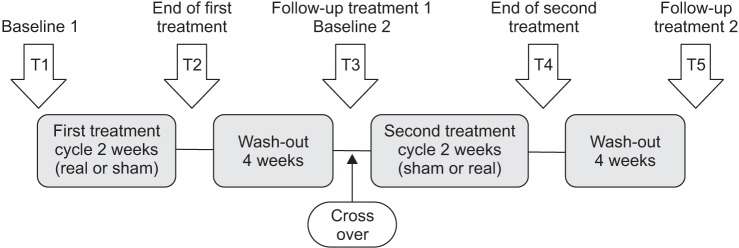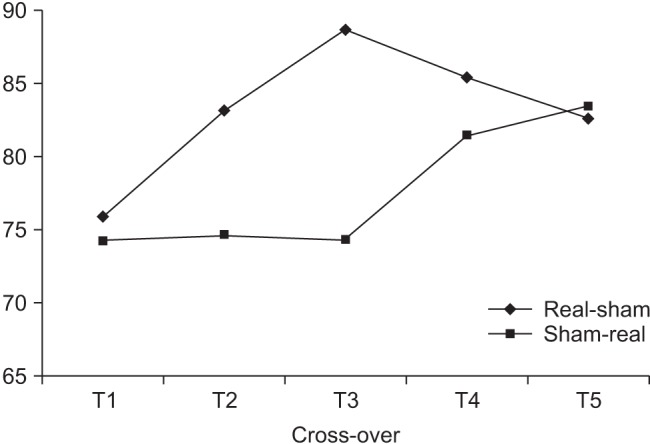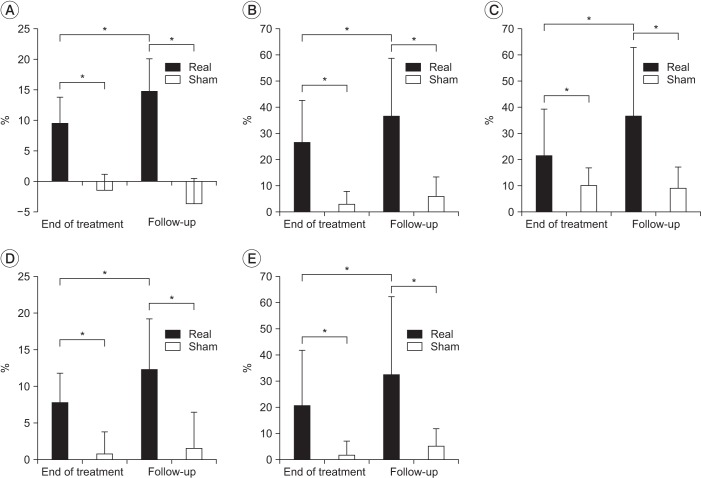Ann Rehabil Med.
2016 Oct;40(5):826-834. 10.5535/arm.2016.40.5.826.
Effects of Repetitive Transcranial Magnetic Stimulation Over Trunk Motor Spot on Balance Function in Stroke Patients
- Affiliations
-
- 1Department of Rehabilitation Medicine, Gwangju Veterans Hospital, Gwangju, Korea. standupmd@hanmail.net
- KMID: 2382914
- DOI: http://doi.org/10.5535/arm.2016.40.5.826
Abstract
OBJECTIVE
To assess the efficacy of high-frequency repetitive transcranial magnetic stimulation (rTMS) on balance function in patients with chronic stroke.
METHODS
Thirty participants with chronic stroke were enrolled in this study. High frequency (10 Hz) rTMS was delivered with butterfly-coil on trunk motor spot. Each patient received both real and sham rTMS in a random sequence. The rTMS cycles (real or sham) were composed of 10 sessions each, administered over two weeks, and separated by a 4-week washout period. Balance function was measured by Berg Balance Scale and computerized dynamic posturography to determine the effect of rTMS before and one day after the end of each treatment period, as well as at a 1-month follow-up.
RESULTS
The balance function was significantly improved after high frequency rTMS as compared with that after sham rTMS (p<0.05). There was no serious adverse effect in patients during the treatment period.
CONCLUSION
In the chronic stroke patients, high frequency rTMS to the trunk motor area seems to be a helpful way to improve balance function without any specific adverse effects. Further studies are needed to identify the underlying mechanism and generate a detailed protocol.
MeSH Terms
Figure
Cited by 1 articles
-
An Erratum to Correct Typographical Errors
Ann Rehabil Med. 2016;40(6):1151-1151. doi: 10.5535/arm.2016.40.6.1151.
Reference
-
1. Alberts JL, Wolf SL. The use of kinetics as a marker for manual dexterity after stroke and stroke recovery. Top Stroke Rehabil. 2009; 16:223–236. PMID: 19740729.
Article2. Scott WG, Scott H. Ischaemic stroke in New Zealand: an economic study. N Z Med J. 1994; 107:443–446. PMID: 7970352.3. Tyson SF, Hanley M, Chillala J, Selley AB, Tallis RC. The relationship between balance, disability, and recovery after stroke: predictive validity of the Brunel Balance Assessment. Neurorehabil Neural Repair. 2007; 21:341–346. PMID: 17353462.
Article4. Laufer Y, Sivan D, Schwarzmann R, Sprecher E. Standing balance and functional recovery of patients with right and left hemiparesis in the early stages of rehabilitation. Neurorehabil Neural Repair. 2003; 17:207–213. PMID: 14677216.
Article5. Geiger RA, Allen JB, O'Keefe J, Hicks RR. Balance and mobility following stroke: effects of physical therapy interventions with and without biofeedback/forceplate training. Phys Ther. 2001; 81:995–1005. PMID: 11276182.
Article6. Bourbonnais D, Bilodeau S, Lepage Y, Beaudoin N, Gravel D, Forget R. Effect of force-feedback treatments in patients with chronic motor deficits after a stroke. Am J Phys Med Rehabil. 2002; 81:890–897. PMID: 12447087.
Article7. Juneja G, Czyrny JJ, Linn RT. Admission balance and outcomes of patients admitted for acute inpatient rehabilitation. Am J Phys Med Rehabil. 1998; 77:388–393. PMID: 9798829.8. Nichols DS, Miller L, Colby LA, Pease WS. Sitting balance: its relation to function in individuals with hemiparesis. Arch Phys Med Rehabil. 1996; 77:865–869. PMID: 8822675.
Article9. Rubenstein LZ, Josephson KR. The epidemiology of falls and syncope. Clin Geriatr Med. 2002; 18:141–158. PMID: 12180240.
Article10. Nowak DA, Grefkes C, Ameli M, Fink GR. Interhemispheric competition after stroke: brain stimulation to enhance recovery of function of the affected hand. Neurorehabil Neural Repair. 2009; 23:641–656. PMID: 19531606.
Article11. Webster BR, Celnik PA, Cohen LG. Noninvasive brain stimulation in stroke rehabilitation. NeuroRx. 2006; 3:474–481. PMID: 17012061.
Article12. Fregni F, Boggio PS, Mansur CG, Wagner T, Ferreira MJ, Lima MC, et al. Transcranial direct current stimulation of the unaffected hemisphere in stroke patients. Neuroreport. 2005; 16:1551–1555. PMID: 16148743.
Article13. Hummel FC, Cohen LG. Non-invasive brain stimulation: a new strategy to improve neurorehabilitation after stroke? Lancet Neurol. 2006; 5:708–712. PMID: 16857577.
Article14. Lefaucheur JP, Andre-Obadia N, Antal A, Ayache SS, Baeken C, Benninger DH, et al. Evidence-based guidelines on the therapeutic use of repetitive transcranial magnetic stimulation (rTMS). Clin Neurophysiol. 2014; 125:2150–2206. PMID: 25034472.
Article15. Sohn MK, Jee SJ, Kim YW. Effect of transcranial direct current stimulation on postural stability and lower extremity strength in hemiplegic stroke patients. Ann Rehabil Med. 2013; 37:759–765. PMID: 24466510.
Article16. Franchignoni FP, Tesio L, Ricupero C, Martino MT. Trunk control test as an early predictor of stroke rehabilitation outcome. Stroke. 1997; 28:1382–1385. PMID: 9227687.
Article17. Hsieh CL, Sheu CF, Hsueh IP, Wang CH. Trunk control as an early predictor of comprehensive activities of daily living function in stroke patients. Stroke. 2002; 33:2626–2630. PMID: 12411652.
Article18. Karatas M, Cetin N, Bayramoglu M, Dilek A. Trunk muscle strength in relation to balance and functional disability in unihemispheric stroke patients. Am J Phys Med Rehabil. 2004; 83:81–87. PMID: 14758293.
Article19. Verheyden G, Vereeck L, Truijen S, Troch M, Herregodts I, Lafosse C, et al. Trunk performance after stroke and the relationship with balance, gait and functional ability. Clin Rehabil. 2006; 20:451–458. PMID: 16774097.
Article20. Likhi M, Jidesh VV, Kanagaraj R, George JK. Does trunk, arm, or leg control correlate best with overall function in stroke subjects? Top Stroke Rehabil. 2013; 20:62–67. PMID: 23340072.
Article21. Kobayashi M, Takahashi K, Sato M, Usuda S. Association of performance of standing turns with physical impairments and walking ability in patients with hemiparetic stroke. J Phys Ther Sci. 2015; 27:75–78. PMID: 25642042.
Article22. Park SH, Song KS, Ko MH, Seo JH. Motor evoked potentials of trunk muscles in stroke patients. J Korean Acad Rehabil Med. 2009; 33:282–289.23. O'Sullivan PB, Grahamslaw KM, Kendell M, Lapenskie SC, Moller NE, Richards KV. The effect of different standing and sitting postures on trunk muscle activity in a pain-free population. Spine (Phila Pa 1976). 2002; 27:1238–1244. PMID: 12045525.24. Dickstein R, Sheffi S, Ben Haim Z, Shabtai E, Markovici E. Activation of flexor and extensor trunk muscles in hemiparesis. Am J Phys Med Rehabil. 2000; 79:228–234. PMID: 10821307.
Article25. Dickstein R, Shefi S, Marcovitz E, Villa Y. Anticipatory postural adjustment in selected trunk muscles in post stroke hemiparetic patients. Arch Phys Med Rehabil. 2004; 85:261–267. PMID: 14966711.26. Chieffo R, De Prezzo S, Houdayer E, Nuara A, Di Maggio G, Coppi E, et al. Deep repetitive transcranial magnetic stimulation with H-coil on lower limb motor function in chronic stroke: a pilot study. Arch Phys Med Rehabil. 2014; 95:1141–1147. PMID: 24625546.
Article27. Murase N, Duque J, Mazzocchio R, Cohen LG. Influence of interhemispheric interactions on motor function in chronic stroke. Ann Neurol. 2004; 55:400–409. PMID: 14991818.
Article28. Shimizu T, Hosaki A, Hino T, Sato M, Komori T, Hirai S, et al. Motor cortical disinhibition in the unaffected hemisphere after unilateral cortical stroke. Brain. 2002; 8. 125(Pt 8):1896–1907. PMID: 12135979.
Article29. Liepert J, Hamzei F, Weiller C. Motor cortex disinhibition of the unaffected hemisphere after acute stroke. Muscle Nerve. 2000; 23:1761–1763. PMID: 11054757.
Article30. Liepert J, Restemeyer C, Kucinski T, Zittel S, Weiller C. Motor strokes: the lesion location determines motor excitability changes. Stroke. 2005; 36:2648–2653. PMID: 16269647.
- Full Text Links
- Actions
-
Cited
- CITED
-
- Close
- Share
- Similar articles
-
- Stroke Update 2011: Stroke Rehabilitation
- The Effect of High Frequency Repetitive Transcranial Magnetic Stimulation on the Motor Function in Post-Stroke Patients
- Application of Non-invasive Brain Stimulation on Dysphagia after Stroke
- Motor Recovery after Seizure Induced by Repetitive Transcranial Magnetic Stimulation
- Factors Associated With Upper Extremity Motor Recovery After Repetitive Transcranial Magnetic Stimulation in Stroke Patients




